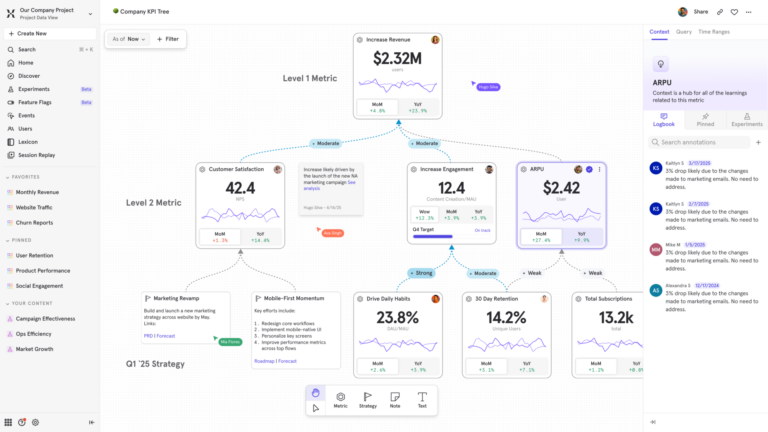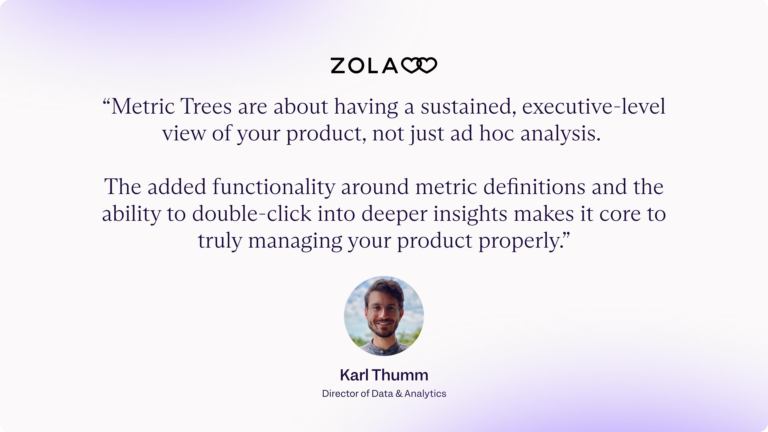
Introducing Metric Trees: Enabling strategic clarity for the digital era

Today, teams are tracking dozens—sometimes hundreds—of metrics. Dashboards light up, trends shift, and priorities scramble. Yet few can clearly articulate:
- Which metrics really matter?
- How are they connected?
- What’s driving movement—and why?
For years, Mixpanel has empowered teams to dig deep into their data and uncover insights—answering tough questions and making faster, smarter decisions across product, marketing, and growth. But until now, most of that work has been reactive: chasing changes, responding to trends, and adjusting course.
Today, we’re changing the game. We’re building the foundation for digital continuous innovation.
Meet Metric Trees
Metric Trees are a new way to bring clarity, alignment, and strategic traceability to your priority metrics. A new way to enable proactive decision-making and accelerate moving from insights to impact.

Bringing structure to the madness
Having spent five years as a strategy consultant, I saw the same general theme arise in every engagement: executives struggle to create rituals and mechanisms that drive alignment and structure within their teams. Every planning cycle is a race until the last minute.
Digital strategy is no different.
Metric Trees solve this by empowering you to visually structure your metrics—from top-level KPIs to the granular levers that influence them. Finally, teams get a shared map of what drives impact, not just a list of metrics.
Think of it as the strategy layer your dashboards have been missing.
Why we built Metric Trees (and why customers are surprised)
When we rolled this out to beta, a customer CPO said:
“There are some areas I expected Mixpanel to get into, but ‘Metric Trees’ wasn't something I even thought of. But once I saw it, I needed it, and it automatically starts making me think of how this could solve so many of our top problems.”
And that’s the point.
We’ve heard it repeatedly: teams are craving traceability—not just seeing what changed, but understanding why and what to do next. Metric Trees make that possible by bridging the gap between dashboards and decisions. It’s not just another shiny chart, or a simple framework in Figma without real-time data or interactivity.
You can now:
- Align teams around a clear set of metric relationships
- See how experiments or features cascade across metrics
- Move from reactive analysis to proactive strategy

💡 Pro tip: Go here to see best practices in building a metrics strategy using metric trees.
AI needs context—Metric Trees provide it
Generative AI can summarize dashboards, surface anomalies, and answer natural language queries, and maybe even create a version of the tree. We’re as excited as anyone about what’s possible.
But here’s the thing: Your AI is only as good as your context.
AI can’t invent your business logic. It can’t guess your strategy. And it definitely can’t align cross-functional teams around goals they don’t understand.
Even in an AI-first world:
- You still need structure. AI can explore, but it needs guardrails. It’s what makes insights interpretable and trustworthy.
- Strategy still needs sign-off. No two businesses, even in the same vertical, optimize the same way. They have different levers.
- Collaboration and context still matter, and maybe more than ever now. Teams work better when they’re aligned around a shared model of how the product works. They need a system that reflects their product logic
Metric Trees are the foundation for what’s next
Metric Trees aren’t just about visibility—they’re about enabling smarter, more grounded decision-making across the board. And they unlock a powerful foundation for where we see digital analytics going.
We see the future where:
- Our co-pilot won’t just respond or summarize charts—it’ll reason and take action because now, it has context.
- Scenario modeling becomes a natural extension of your Mixpanel strategy map. Want to simulate what happens if a key input improves by 10%? We’ll show you.
- Root cause analysis is context-aware and will pinpoint why something moved within the structure you’ve defined.
It’s early, but we see Metric Trees as laying the groundwork for this kind of intelligence, which makes digital analytics AI powerful and trustworthy. Not AI for AI’s sake, but AI that’s useful because it understands how your product actually works.
For execs, this means faster decisions and fewer fire drills
You don’t need another dashboard. You need clarity, traceability, alignment, and a trusted metrics hub—especially as teams scale and products grow more complex.
With Metric Trees:
- Know what to optimize – Clear visibility into priorities at every level.
- Assign clear accountability – Every key metric has a defined owner.
- Link directly to KPIs – Tie experiments and feature metrics to business outcomes.
- Make strategy live – Move your product strategy out of static decks and into your analytics.
- Decide with full context – All metric history, relationships, and ownership in one place for truly holistic decisions.
💡 Pro tip: Learn how to operationalize your growth strategy in our ebook, Beyond the North Star.
One final thought
All the noise right now about AI is exciting, but it’s also easy to lose the plot.
At Mixpanel, we’re focused on something quieter—but more durable: building the structures that make product, marketing and growth teams sharper, faster, and more aligned.
Metric Trees are just the beginning.
Bring structure to the madness, move faster with more clarity, and build the foundation for AI-powered digital continuous innovation for your organization going forward. Contact us for a Metric Trees demo today.


